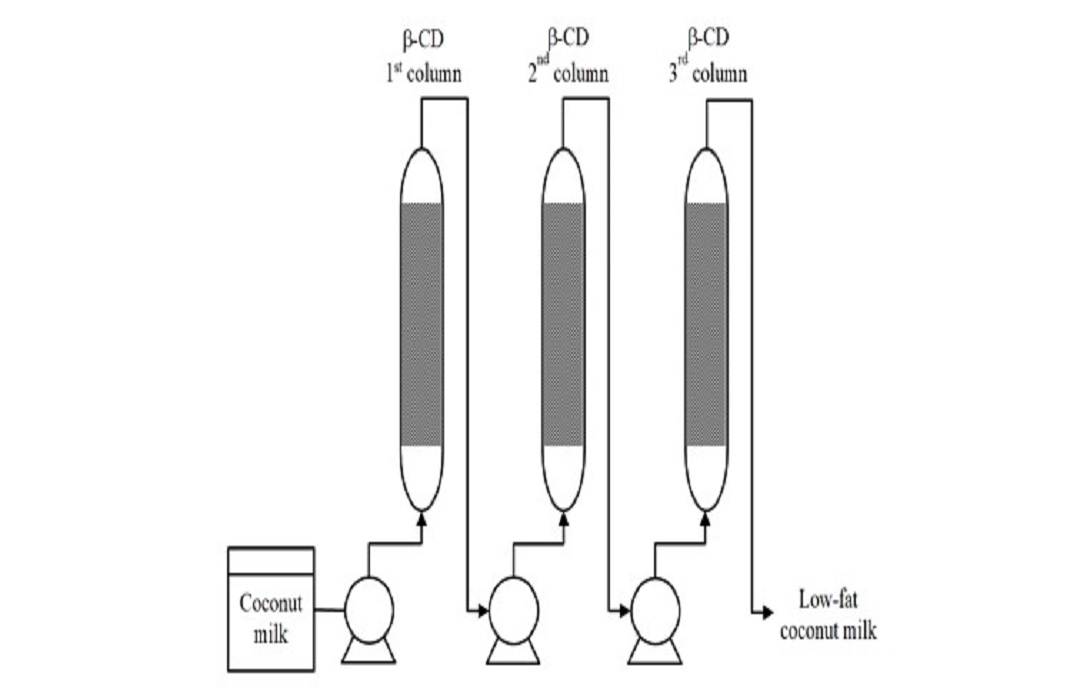Production of Low-Fat Coconut Milk Using -Cyclodextrin Column for Selective Removal of Saturated Fatty Acids
DOI:
https://doi.org/10.14456/nujst.2023.38Keywords:
Coconut milk, saturated fatty acids, -cyclodextrin, fatty acid recoveryAbstract
The objective of this study was to develop a low-fat coconut milk product by selectively removing saturated fatty acids from coconut milk using b-cyclodextrin (b-CD). The optimal b-CD loading was 50% weight per milk volume at a temperature of 4°C and contact time of 30 min. Approximately 48.9±0.8% of the total fatty acids, especially lauric acid, were removed. A continuous process for fat removal was developed using consecutive b-CD columns. The fat contents in the coconut milk after passing through the first b-CD column were reduced from 18.9±0.4% to 10.5±0.3% and passing through the second b-CD column reduced the fat contents by a further 6.7±0.1%. Interestingly, these fatty acids can be recovered, and b-CD can be reused after elution by ethanol. The sensory evaluation showed that the low-fat coconut milk from the 1st column was acceptable and comparable to the raw material while having a lower fat content. This study has shown the practical and effective application of b-CD for removing medium-chain saturated fatty acids and may apply to other types of high-fat raw materials, creating healthy choices for consumers.
References
Alyaqoubi, S. R., Abdullah, A., Samudi, M., Abdullah, N., Addai, Z. R., & Musa, K. H. (2015). Study of antioxidant activity and physicochemical properties of coconut milk (Pati santan) in Malaysia. Journal of Chemical and Pharmaceutical Research, 7(4), 967-973.
Astray, G., Mejuto, J. C., & Simal-Gandara, J. (2020). Latest developments in the application of cyclodextrin host-guest complexes in beverage technology processes. Food Hydrocolloids 106, 105882. https://doi.org/10.1016/j.foodhyd.2020.105882
Christoforides, E., Papaioannou, A., & Bethanis, K. (2018). Crystal structure of the inclusion complex of cholesterol in β-cyclodextrin and molecular dynamics studies. Beilstein Journal of Organic Chemistry, 14, 838–848. https://doi.org/10.3762/bjoc.14.69
di Cagno, M.P. (2017). The potential of cyclodextrins as novel active pharmaceutical ingredients, A short overview. Molecules, 22(1), 1. https://doi.org/10.3390/molecules22010001
Gurd, C., Jefferson, B., Villa, R., & Rodriguez, C. (2018). Determination of fats, oils and greases in food service establishment wastewater using a modification of the Gerber method. Water and Environment Journal, 34(5), 1-9. http://dx.doi.org/10.1111/wej.12431
Han, E. M., Kim, S. H., Ahn, J., & Kwak, H. S. (2005). Cholesterol removal from homogenized milk with crosslinked β-cyclodextrin by adipic acid. Asian-Australasian Journal of Animal Sciences, 18(2), 1794-1799. https://doi.org/10.5713/ajas.2005.1794
Jeong, H. J., Sun, H., Chogsom, C., & Kwak, H. S. (2014). Cholesterol removal from whole egg by crosslinked β-Cyclodextrin. Asian-Australasian Journal of Animal Sciences, 27(4), 537-542. https://doi.org/10.5713/ajas.2013.13706
Karunasiri, A.N., Gunawardane, M., Senanayake, C.M., Jayathilaka, N., & Seneviratne, K.N. (2020). Antioxidant and nutritional properties of domestic and commercial coconut milk preparations. International Journal of Food Science, 1, 3489605. https://doi.org/10.1155/2020/3489605
Kukula, M., Kolarič, L., & Šimko, P. (2020). Decrease of cholesterol content in milk by sorption onto β-cyclodextrin crosslinked by tartaric acid, considerations and implications. Acta Chimica Slovaca, 13, 1–6. https://doi.org/10.2478/acs-2020-0024
Kolarič, L., Kántorová, P., & Šimko, P. (2022). β-Cyclodextrin as the key issue in production of acceptable low-cholesterol dairy products. Molecules, 27(9), 2919. https://doi.org/10.3390/molecules27092919
Kolarič, L., & Šimko, P. (2022). Application of β-cyclodextrin in the production of low-cholesterol milk and dairy products. Trends in Food Science and Technology, 119, 13-22. https://doi.org/10.1016/j.tifs.2021.11.023
Mahbub, K., Octaviani, I. D., Astuti, I. Y., Sisunandar, S., & Dhiani, B. A. (2022). Oil from kopyor coconut (Cocos nucifera var. Kopyor) for cosmetic application. Industrial Crops and Products, 186, 115221. https://doi.org/10.1016/j.indcrop.2022.115221
Maskooki, A. M., Beheshti, S. H. R., Valibeigi, S., & Feizi, J. (2013). Effect of cholesterol removal processing using β -Cyclodextrin on main components of milk. International Journal of Food Science, 2013, 1-6. https://doi.org/10.1155/2013/215305
Matencio, A., Navarro-Orcajada, S., García-Garmona, F., & L´opez-Nicol´as, J. M. (2020). Applications of cyclodextrins in food science. A review. Trends in Food Science and Technology, 104, 132–143. https://doi.org/10.1016/j.tifs.2020.08.009
Mudassir, Z., Nadeem, M., & Baig, H. A. (2017). The effect of beta cyclodextrin on the removal of cholesterol from buffalo milk. Pakistan Journal of Scientific and Industrial Research Series, 60(2), 87-91. https://doi.org/10.52763/pjsir.biol.sci.60.2.2017.87.91
Priyananda, P., & Chen, V. (2006). Separation of residual fatty acids from aqueous solutions using an agitated solution of protein and membrane filtration. Separation and Purification Technology, 48(2), 113-120. https://doi.org/10.1016/j.seppur.2005.07.010
Skoulika, S. G., Georgiou, C. A., & Polissiou, M. G. (1999). Interaction of β-cyclodextrin with unsaturated and saturated straight chain fatty acid anions studied by phenolphthalein displacement. Journal of Inclusion Phenomena and Macrocyclic Chemistry, 34, 85–96. https://doi.org/10.1023/A:1008080619470
Srinuanpan, S., Cheirsilp, B., & Prasertsan, P. (2018). Effective biogas upgrading and production of biodiesel feedstocks by strategic cultivation of oleaginous microalgae. Energy, 148, 766-774. https://doi.org/10.1016/j.energy.2018.02.010

Downloads
Published
How to Cite
Issue
Section
License
Copyright (c) 2023 Naresuan University Journal: Science and Technology (NUJST)

This work is licensed under a Creative Commons Attribution-NonCommercial 4.0 International License.













